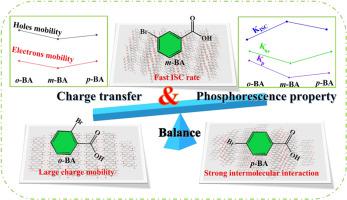Materials Today Chemistry ( IF 6.7 ) Pub Date : 2023-11-21 , DOI: 10.1016/j.mtchem.2023.101814 Huanling Liu , Qingfang Mu , Xin Zhao , Yan Wang , Yuzhi Song , Lili Lin , Chuan-Kui Wang , Jianzhong Fan

|
Purely organic room temperature phosphorescence (RTP) materials have garnered extensive attentions in anti-counterfeiting and encryption, information display, biological imaging and organic light emitting diodes (OLEDs) due to the features of long lifetimes, low toxicity and good biocompatibility. Nevertheless, both the species and amounts of the efficient RTP molecules are far from meeting the requirements for practical applications, and the quantitative relationship between molecular structures and optoelectronic properties needs full elucidated. Herein, the photophysical properties and properties of three isomers (o-BA, m-BA and p-BA) are explored based on the first-principles calculations coupled with thermal vibration correlation function (TVCF) method and kinetic Monte Carlo simulations. The substituent effects on the molecular structures, intermolecular interactions, transition properties, Huang-Rhys factors and reorganization energies, excited state dynamics as well as transfer integrals and charge carrier mobilities are investigated in detail to clarify the structure-property relationships. Results show that o-BA achieves fast radiative rate on account of impressive transition dipole moment and oscillator strength, but equally large non-radiative decay rate leads to low RTP efficiency. Promisingly, the highest holes mobility is determined for o-BA due to the largest transfer integrals of holes originating from the strong intermolecular interactions. In addition, compared with o-BA and p-BA, m-BA could achieve fast intersystem crossing (ISC) rate with large spin orbit coupling constant and low non-radiative decay rate with small geometric structure changes. Relatively balanced holes and electrons mobilities of m-BA have been demonstrated, which contributes to the recombination of excitons and the improvement of luminescence efficiency. For p-BA, the strong intermolecular hydrogen bonding restricts the free rotation of single bonds and promotes the molecular coplanarity, which contributes to efficient emission. Furthermore, the charge mobility is calculated and the temperature dependence is investigated, the hopping mechanisms for studied isomers are illustrated. This work reveals the relationship among molecular structures, crystal packing modes, photophysical properties and charge transport properties of isomers, and provides an insight for molecular design and property prediction.
中文翻译:

结构异构对有机室温磷光分子光电性能影响的理论视角
纯有机室温磷光(RTP)材料由于具有长寿命、低毒性和良好的生物相容性等特点,在防伪加密、信息显示、生物成像和有机发光二极管(OLED)等领域受到广泛关注。然而,高效RTP分子的种类和数量都远远不能满足实际应用的要求,分子结构与光电性能之间的定量关系有待充分阐明。在此,基于第一性原理计算结合热振动相关函数(TVCF)方法和动力学蒙特卡罗模拟,探索了三种异构体( o -BA、m -BA和p -BA)的光物理性质和性质。详细研究了取代基对分子结构、分子间相互作用、过渡性质、Huang-Rhys因子和重组能、激发态动力学以及转移积分和载流子迁移率的影响,以阐明结构-性质关系。结果表明,o -BA 由于具有令人印象深刻的跃迁偶极矩和振荡器强度而实现了快速辐射速率,但同样大的非辐射衰减速率导致 RTP 效率较低。有希望的是,由于强分子间相互作用产生的空穴最大转移积分,o -BA确定了最高的空穴迁移率。此外,与o -BA和p -BA相比,m -BA可以实现快速的系间穿越(ISC)速率,自旋轨道耦合常数大,非辐射衰变率低,几何结构变化小。m -BA具有相对平衡的空穴和电子迁移率,这有助于激子的复合和发光效率的提高。对于p -BA,强的分子间氢键限制了单键的自由旋转并促进了分子共面性,这有助于高效发射。此外,还计算了电荷迁移率并研究了温度依赖性,说明了所研究异构体的跳跃机制。这项工作揭示了异构体的分子结构、晶体堆积模式、光物理性质和电荷传输性质之间的关系,并为分子设计和性质预测提供了见解。

































 京公网安备 11010802027423号
京公网安备 11010802027423号